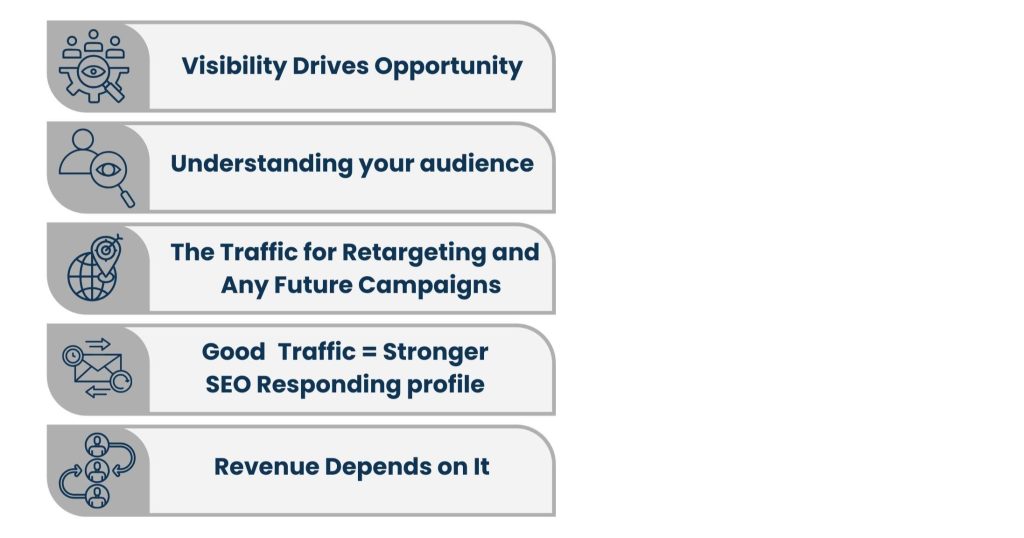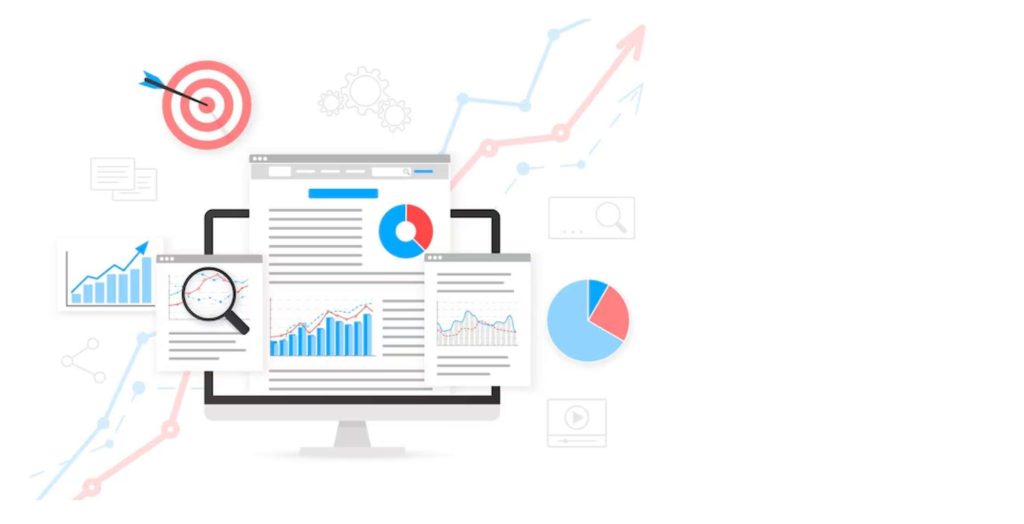Introduction
You’ve set your website up, your campaigns are live, and you’re driving some website traffic, but what’s next? Website analytics can get overwhelming quickly. Pageviews, Sessions, Bounce Rate, Unique, and other such Website Traffic Metrics. We have to clean the clutter.
Whether you’re a business owner, marketer, or content creator, monitoring the right website traffic metrics can help you understand how people are interacting with your website and where you should be directing your attention.
But before you start getting lost in the numbers, consider a simple question: why is website traffic important in the first place? Let’s break that down
Why Website Traffic Matters
Driving traffic to your website is great, but let’s face it, traffic alone doesn’t necessarily pay the bills. Too many businesses chase traffic numbers without first asking a more important question: Is it the right traffic?
This chapter explains why Website traffic metrics, specific kinds and amounts of it, are crucial to business, and how strategically thinking about it can fuel real, consistent business growth.

1. Visibility Drives Opportunity
When individuals arrive on your website, it’s frequently their first encounter with your brand. Be it Google, social media, or a blog, they found you great!
High traffic gets you seen, but visibility with relevance opens up opportunities. The better-fit traffic you can pull in, the more opportunities you’ll have to convert leads, build your email list, or even make sales.
But it’s not enough to just get seen, it’s about being seen by the right people at the right time in their buying journey.
You Learn a Lot About Your Audience From Your Website Traffic.
2. Understanding your audience
One of the greatest benefits of monitoring website traffic is the ability to understand the people visiting your website.
Tools like Google’s Analytics show website traffic metrics, such as where those visitors are coming from, what devices they’re using, how long they stick around, and where on the site they engage most. They teach you the following patterns:
- What topics resonate.
- Where to be effective.
- A place where people are falling out of your funnel.
- What products or services are getting the most attention?
Once you understand user actions, you can personalize content, design, and messaging according to what your audience wants.
3. The Traffic for Retargeting and Any Future Campaigns
All of those users can (ethically) be tracked and retargeted in future ad campaigns. So even if someone doesn’t convert the first time they visit, it doesn’t mean they’re a lost cause forever.
Platforms, such as Meta Ads, Google Ads, and LinkedIn, allow you to display ads directly to people who have already engaged with your site with website traffic metrics. This approach is cheap and effective, since these people already know who you are.
Translation: more traffic = more leverage for your marketing in the future.
4. Good Traffic = Stronger SEO Responding profile
As search engines notice that users are interacting with your website, sticking around longer, visiting multiple pages, and not bouncing, they take that as a quality signal.
This results in better Google rankings in the long run. So, your site traffic isn’t just a product of SEO, it’s also a driver of SEO success.
Observing how users are navigating through your content can also indicate what else to optimize, what to promote, and what to update.
5. Revenue Depends on It
Traffic at the end of the day is the first step in virtually every online business model. If you are selling products, booking appointments, or building lists of leads, no visitors means no conversions.
You’re not wishing for the website traffic itself but for that traffic to convert. But there are not enough website traffic metrics for testing and measurement to help sort out what works.
More high-quality traffic leads to more chances to test, optimize, and scale your revenue; it’s that simple.
Below, we dissect the most useful of those metrics and what they’re telling you, along with a few tips for how to improve in the metrics that do matter.
Also Read: Virtual Assistant Services in Bettembourg
The Top Website Traffic Metrics That Matter
1. Total Website Traffic

This is the number of times people come to your site over a specific period. It’s your basic, oldest picture of visibility.
- What it tells you: How many people are heading to your site. It refers to each session, whether you got it from new users or returning users, so you have a sense of how much your site is being used in total. It’s a kind of place to look at traffic trends over time.
- Why it matters: It’s a good high-level gauge of how well your marketing is performing. But volume alone doesn’t equal success. Surges in traffic might feel good, but if those visitors aren’t engaging or converting, you might be attracting the wrong audience. That’s why this number should always be put up against deeper engagement metrics.
- Pro Tip: Always couple this metric with others, such as engagement and conversion, to get the full picture. Consider it your headline number, but not the entire story.
2. Unique Visitors

Unique visitors stand for the total number of individual people visiting your site (in contrast to total visits, which can count repeat visitors).
- What it tells you: Who you have reached. This measure allows you to know how many visitors you are attracting to your brand in a given period. It is particularly important when comparing the reach from work on brand awareness or a new campaign.
- Why it matters: If there are a lot of visits to a site but not many unique visitors, you might be seeing a lot of return visits by the same people, or by bots. A consistent growth of unique visitors indicates that you’re reaching new people with your content or promotions. On the other hand, if you have low or decreasing follower numbers, they may be telling you that your outreach has become stagnant.
- Pro Tip: This is one of the most important metrics to grasp when you are trying to understand reach, particularly with brand awareness campaigns. Use it as a guideline for when you’re pushing an ad, content series, or partnership.
3. Bounce Rate

Bounce rate is the website traffic metric showing the proportion of people who leave your site without visiting more than one page.
- What it tells you: If people are getting what they need, or departing too soon. It is an indication of how interesting or relevant your landing page is to your visitors. A high bounce rate can reflect a failure to meet user expectations.
- Why it matters: A high bounce rate can mean the page isn’t engaging, takes too long to load, or doesn’t meet expectations. When users come and bounce without engaging, you’re losing leads and some very valuable traffic. It’s also incredibly valuable for pinpointing content, navigation, or calls-to-action weaknesses.
- Pro Tip: Bounce rate is not always terrible – blog posts and landing pages often have higher natural bounce rates if they only need to accomplish one task. The context is important – always take a look at intent and the type of content.
4. Average Session Duration

This is the average time that someone spends on your site on a visit.
- What it tells you: How engaged your viewers are. If you have people spending several minutes on your site, reading or watching, they see that your content is valuable. Low duration can either indicate that people aren’t engaging with your site or that the content is superficial.
- Background: The longer someone sticks around, the higher the chance they will convert or take action. Time on site is frequently the closest thing you will have to an early indicator of interest, especially if you are a content-driven organization or service provider. If the duration is constantly short, you might consider redesigning your user flow or creating some rich interaction on the page.
Alright, so if session duration is low, I’m gonna check the content structure, internal linking, and page load speed. The point isn’t simply to keep users around longer — it’s to keep them interacting with what matters.
5. Traffic Sources

This tells you where your traffic is coming from: organic search, direct, referral, paid ads, or social media.
- What it says: What channels are working well for you? You’ll get a breakdown of how users are finding you — whether they clicked on a search result, typed in your URL, or came from another website. That way, you know which of your marketing efforts is going strong.
- Why it matters: It gives you the tools and analytics to invest more wisely in marketing. If 70 percent of your traffic is coming from search, you might decide you need to double down on SEO. Risks are even evident — if one channel is responsible for most of your traffic and it dries up, so will your entire funnel. Diverse streams of traffic give more resilience and control.
- Pro Tip: Don’t depend on one channel. If all the traffic to your site comes from a single source, you leave yourself open to changes in that industry or ad budget cuts. Test campaigns with it and pivot based on performance.
6. Pages Per Session

This tells you how many pages a user loads in one visit.
- What it shows you: How effective your content and navigation are at promoting more engaged use. If people keep clicking through to the next page, they must be interested. That may be a sign that your site’s layout is intuitive and that your internal links are strong.
- Why it matters: The more pages per session, the more potential for interest and conversion. It’s also a signal that your site is sticky, that it keeps people clicking rather than bouncing. Low page views could indicate users aren’t finding what they are looking for, or are encountering dead ends.
- Pro Tip: Incorporate some prudent internal linking and obvious CTAs that take users by the hand and direct them through your website. If relevant, recommend further blog posts or services to engage with.
7. New vs. Returning Visitors

This Website Traffic Metric tells you what percentage of your visitors are new to your site, as opposed to returning.
- What you learn: Are you drawing new people or earning loyalty? New visitors are a sign that your outreach is working, while returning users indicate that your product or content is so good that it draws people back. A good blend suggests that both are working effectively, that acquisition and retention are alive and well.
- Why it matters: A good website does both. Too many new users and no repeat traffic could be a sign of bad retention. Or, on the other hand, if your site only has returning traffic, this might mean you’re not gaining access to new audiences. Leverage this information to optimize content strategy or audience targeting.
- Pro Tip: Watch this over time to see how different campaigns or content updates affect return visits. You might offer incentives, or newsletter opt-ins, to help first-timers come back.
Also Read: Virtual Assistant Services in Differdange
8. Conversion Rate

This is the proportion of visitors who perform an action we desire (buy something, sign up, call you, etc).
- What it tells you: How effective your website is at converting visitors to customers or leads. It’s the most straightforward measure of whether your site is fulfilling its purpose and getting results that make a difference. High traffic, low conversions can often indicate a gap between what your audience is expecting and what your actual site experience delivers.
- Why it matters: Just having foot traffic is worthless if it doesn’t convert to results. If you have a site with a ton of traffic and terrible conversion, that is a sign of an issue that needs significant UX or Offer fixes. Your conversion rate indicates where friction happens — be it confusing copy, a faulty form, or an unattractive call-to-action.
- Pro Tip: Always measure conversions by source, in order to identify which channels are bringing you the most relevant traffic. Traffic is not created equal, nor does all traffic convert the same.
Conclusion
It’s easy to be swayed by vanity metrics such as “more traffic” or “more pageviews.” But smart companies understand that website traffic metrics are only valuable when they translate into action. Numbers without context don’t convey the whole story. The most important thing, however, is knowing who your visitors are, what they are doing on your site, and whether that behavior aligns with your business goals.
“Don’t just chase volume, focus on the quality of your traffic. From where do these visitors come? Are they staying? Are they converting? When you begin to answer those questions, your data becomes a decision-making tool, not just a report.
By measuring the right metrics, you can tailor your strategy, make adjustments to optimize user experience, and allocate resources where they will make the most meaningful difference. Numbers aren’t just numbers; they’re stories about your audience, your content, and your business performance.
You will no longer stare at your screen, merely at a number from the past, but at the story behind it.
At Tasks Experts, our VAs are trained to track website metrics like a pro and suggest some strategies to enhance the website’s performance. If you want to leverage our expertise, contact us today.
About Us
Tasks Expert offers top-tier virtual assistant services from highly skilled professionals based in India. Our VAs handle a wide range of tasks, from part time personal assistant to specialized services like remote it support services, professional bookkeeping service etc. Furthermore, it helps businesses worldwide streamline operations and boost productivity.
Ready to elevate your business? Book a Call and let Tasks Expert take care of the rest.










